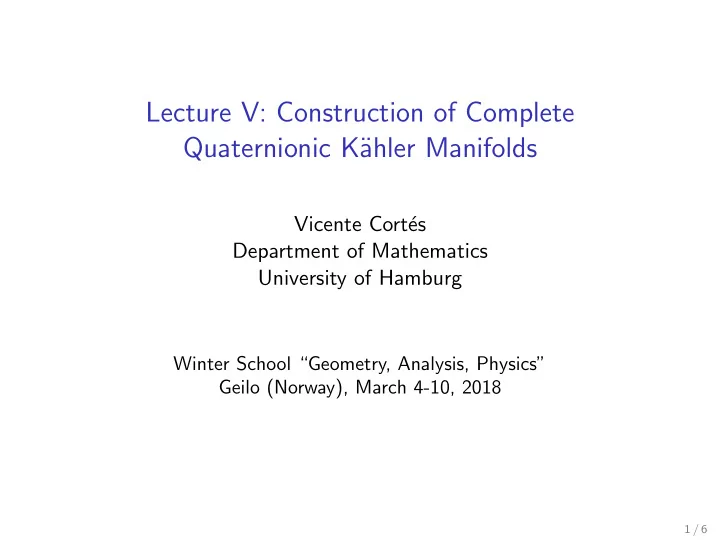

Lecture V: Construction of Complete Quaternionic K¨ ahler Manifolds Vicente Cort´ es Department of Mathematics University of Hamburg Winter School “Geometry, Analysis, Physics” Geilo (Norway), March 4-10, 2018 1 / 6
Some references for Lecture V [CDJL] C.–, Dyckmanns, Juengling, Lindemann, math.DG:1701.7882 [CDS] C.–, Dyckmanns, Suhr (Springer INdAM ‘17) [CDL] C.–, Dyckmanns, Lindemann (PLMS ‘14) [CHM] C.–, Han, Mohaupt (CMP ‘12). [L] LeBrun (Duke ‘91). Plan of the fifth lecture: ◮ Completeness results for the one-loop deformation. ◮ Classification results for complete PSR mfs. and corresponding QK mfs. 2 / 6
Completeness of the one-loop corrected c-map metric Theorem [CDS] Let ( ¯ M , ¯ g ) be a PSK manifold with regular boundary behaviour. Then the corresponding one-loop deformation g c FS is a family of complete QK metrics for c ≥ 0. Consider the supergravity q-map, which is the composition of the supergravity r- and c-maps. Theorem [CDS,CHM] The one-loop deformed sugra q-map associates a family of complete QK manifolds of dim. 4 n + 8 (of scal < 0) depending on a parameter c ≥ 0 with every complete projective special real manifold of dimension n . = ⇒ it is interesting to classify complete PSR manifolds 3 / 6
One-loop deformation of symmetric spaces Corollary [CDS] All known homog. QK mfs. of scal < 0 can be deformed in this way by complete QK manifolds, with exception of H H n . Proof ◮ All of these homog. spaces with exception of Gr 2 ( C n +3 ) ∗ are in the image of the q-map. ◮ Gr 2 ( C n +3 ) ∗ = c ( C H n ) and the PSK manifold C H n has regular boundary behaviour. Remark The quaternionic hyperbolic spaces H H n were already known to admit deformations by complete QK metrics [L]. 4 / 6
Classification of complete PSR curves and surfaces Theorem [CHM] There are only 2 complete PSR curves (up to equivalence): i) { ( x , y ) ∈ R 2 | x 2 y = 1 , x > 0 } , ii) { ( x , y ) ∈ R 2 | x ( x 2 − y 2 ) = 1 , x > 0 } . Theorem [CDL] There are only 5 discrete examples and a 1-parameter family of complete PSR surfaces: a) { ( x , y , z ) ∈ R 3 | xyz = 1 , x > 0 , y > 0 } , b) { ( x , y , z ) ∈ R 3 | x ( xy − z 2 ) = 1 , x > 0 } , c) { ( x , y , z ) ∈ R 3 | x ( yz + x 2 ) = 1 , x < 0 , y > 0 } , d) { ( x , y , z ) ∈ R 3 | z ( x 2 + y 2 − z 2 ) , z < 0 } , e) { ( x , y , z ) ∈ R 3 | x ( y 2 − z 2 ) + y 3 = 1 , y < 0 , x > 0 } , f) {· · · | y 2 z − 4 x 3 + 3 xz 2 + bz 3 = 1 , z < 0 , 2 x > z } , b ∈ ( − 1 , 1). ◮ q-map → complete QK manifolds of co-homogeneity ≤ 2. 5 / 6
Classification of complete PSR manifolds with reducible cubic polynomial Theorem[CDJL] Every complete PSR manifold H ⊂ { h = 1 } ⊂ R n +1 , n ≥ 2, for which h is reducible is linearly equivalent to exactly one of the following: a) { x n +1 ( � n − 1 i =1 x 2 i − x 2 n ) = 1 , x n +1 < 0 , x n > 0 } , b) { ( x 1 + x n +1 )( � n i =1 x 2 i − x 2 n +1 ) = 1 , x 1 + x n +1 < 0 } , c) { x 1 ( � n i =1 x 2 i − x 2 n +1 ) = 1 , x 1 < 0 , x n +1 > 0 } , 1 − � n +1 d) { x 1 ( x 2 i =2 x 2 i ) = 1 , x 1 > 0 } . ◮ Under the q-map, these are mapped to complete QK manifolds of co-homogeneity ≤ 1. ◮ The series d) is mapped to a series of complete QK manifolds of co-homogeneity 1. 6 / 6
Recommend
More recommend